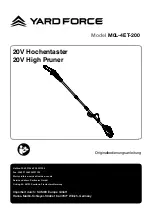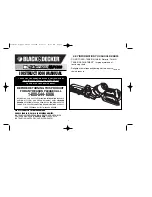
12
OPERATING YOUR MITRE SAW
WARNING:
To avoid serious personal injury, always
keep your hands outside the no hands zone, at
least 75mm from the blade. Never perform a cutting
operation without holding the workpiece against the
fence. The blade could grab the workpiece if it slips or
twists.
PLACING MOLDING FLAT ON THE MITRE TABLE
To use this method for accurately cutting crown molding
for a 90° inside or outside corner, lay the molding with
its broad back surface flat on the mitre table and against
the fence.
When setting the bevel and miter angles for compound
mitres, remember that the settings are interdependent,
changing on angle changes the other angle as well.
Keep in mind that the angles for crown moldings are very
precise and difficult to set. Since it is very easy for these
angles to shift, all settings should first be tests on a scrap
molding. Also most walls do not have angles of exactly
90° therefore, you will need to finetune your setting.
CUTTING WARPED MATERIAL (Fig. 23 & 24)
When cutting warped material, always make sure it is
positioned on the mitre table with convex side against
the fence.
If the warped material is positioned the wrong way , it will
pinch the blade near the completion of the cut.
WARNING:
To avoid a kickback and to avoid serious
personal injury, never position the concave edge of
bowed or warped material against the fence.
LASER BEAM (Fig.25)
The light from the laser beam allows you to line up
precisely the cutting angle and the exact position of the
workpiece on the bench.
The laser beam can be switched on as required:
Press laser ON/OFF switch (26 ) to turn the laser (25).
The network cable supplies power to the laser. The laser
beam should be aligned before being used for the first
time.
■
Set table to mitre position 0°.
■
Loosen off laser-alignment screw (27) slightly.
■
Switch the laser on and align the beam so that it
points exactly at the 0°.
MANTENANCE
GENERAL
Avoid using solvents when cleaning plastic parts. Most
plastics are susceptible to damage from various types
of chemical solvents and may be damaged by their use.
Use clean rags to remove dirt, carbon dust etc.
EXTENSION CORDS
The use of any extension cord will cause some loss of
power. To keep power loss to a minimum and to prevent
tool overheating, use an extension cord that is heavy
enough to carry the current the tool will draw.
If the supply cord is damaged have it replaced by the
manufacturer or its service agent in order to avoid a
hazard. Disconnect from the supply immediately if the
supply cable is damaged.
EMS-1422Lmanual (SAA).indd Sec1:12
EMS-1422Lmanual (SAA).indd Sec1:12
1/8/08 10:53:29 AM
1/8/08 10:53:29 AM































